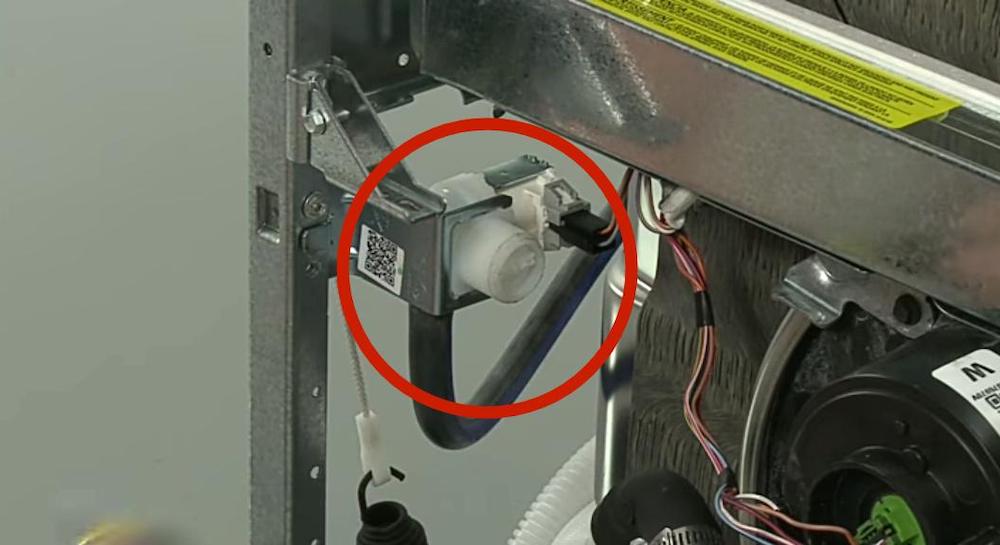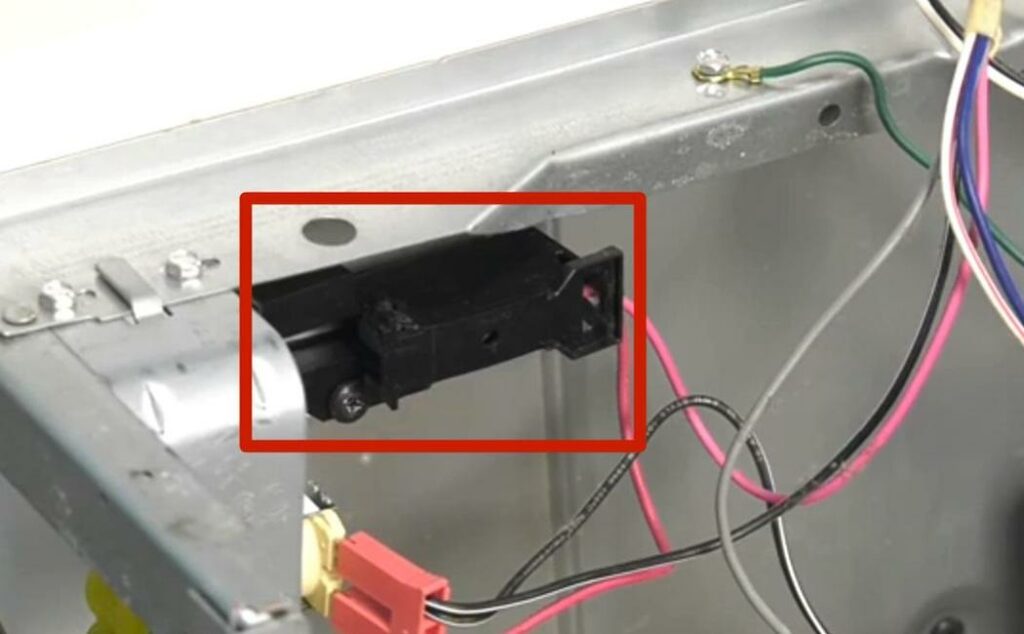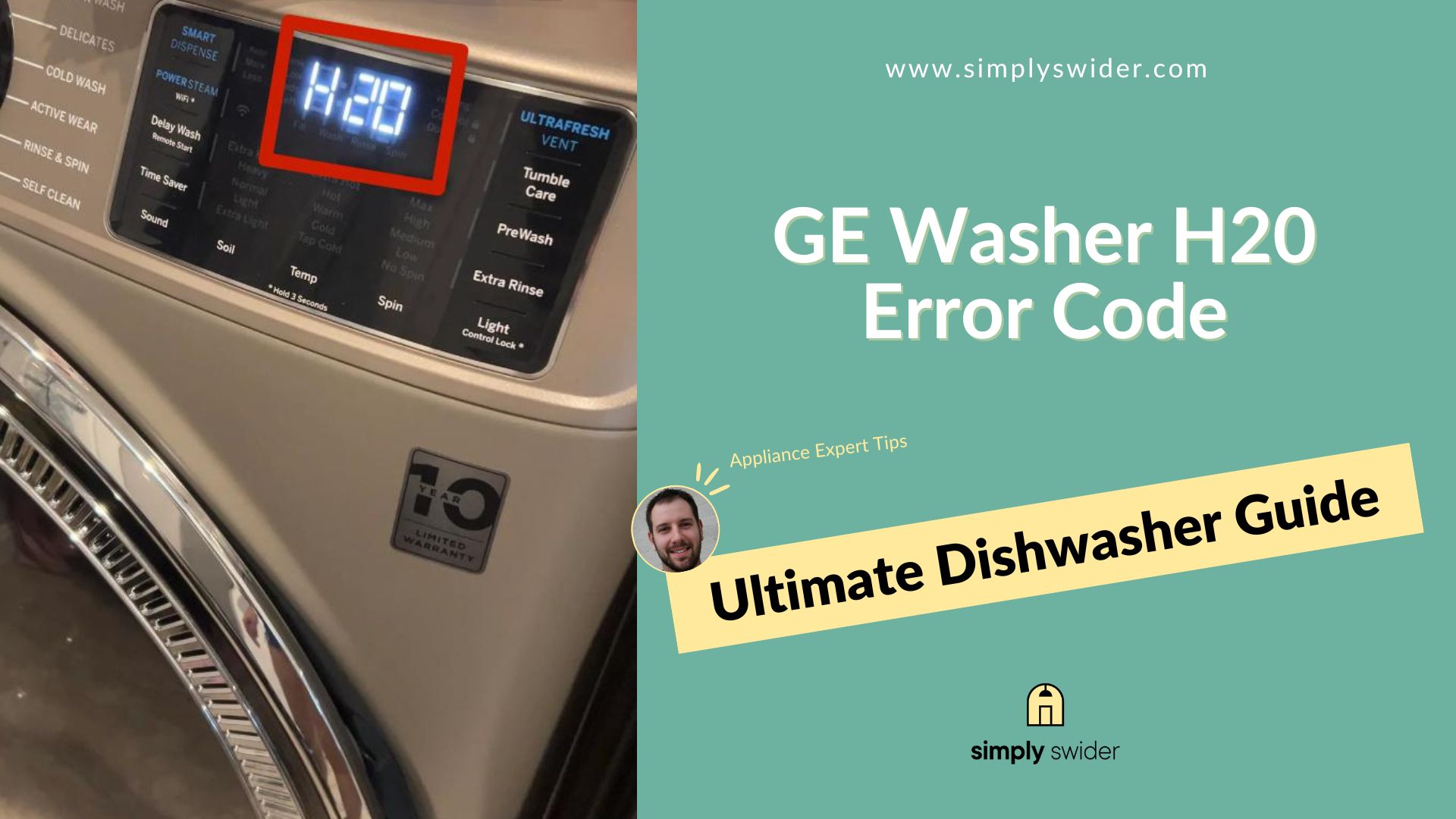Fact:
Dishwasher malfunctions are the most frustrating thing.
I’ve encountered multiple error codes while repairing GE Dishwashers, and the H20 error is one of the most common. And I’m not the only one who thinks so.
In fact:
My close friend and expert technician, Roy Callaghan from Arlington, Texas, agrees that H20 errors are more popular than we think.
Fortunately:
They are also super easy to fix, and I’ll show you how.
So:
In this piece, I’ll share Roy’s and my expert tips for rectifying the H20 error on your GE Dishwasher.
Ready?
Table of Contents
What Is GE Dishwasher H20 Error?
The GE dishwasher H20 error is a code that appears on your GE dishwasher’s display when there’s a fault in the water supply. According to GE Appliances, the H20 error indicates that the dishwasher isn’t getting enough or any water. This could be due to faulty parts or low water pressure.
Now:
To help you understand how to handle this error, I sought the expertise of my friend Roy Callaghan, and I’ve applied the principles myself. So, in this guide, I’ll describe what causes this error and what to do in each case.
Read on to discover how to solve this issue yourself.
Common Reasons & Troubleshooting for a GE Dishwasher H20 Error
| Commonly Affected Part | Estimated Repair Cost |
|---|---|
| Inlet valve | $18 – $80 |
| Inlet hose | $16 – $32 |
| Pressure sensor | $21 – $32 |
| Float switch | $19 – $46 |
Can I be completely honest?
Although the GE dishwasher H20 error signifies that your machine isn’t getting enough water, fixing the issue isn’t as simple.
In my experience with fixing GE dishwashers, I’ve noticed that identifying the cause of the issue is the most difficult part.
But you don’t have to worry:
With the help of our trusted technician from Arlington, Roy Callaghan, we’ll discuss common reasons for the GE dishwasher H20 error. I’ll also give step-by-step procedures for solving the problem in each case.
Here we go!
1. Insufficient Water Pressure

| Part | Water inlet hose |
| Location | Lower left of the dishwasher |
| Ease of troubleshooting | Easy |
| Note | A clogged inlet hose could lead to insufficient pressure and, eventually, a H20 error display. |
| Cost | $16 – $32 |
| Repairable | No |
According to Roy Callaghan, our friendly home appliance expert, water pressure is highly significant in the water supply to GE dishwashers.
I’ll tell you why.
Problem:
For water to flow to the GE dishwasher, it needs a certain amount of pressure. This force pushes the water up the inlet hose and through the inlet valve.
So:
Water won’t flow properly into the dishwasher if the pressure isn’t adequate. This means if you’re using a dishwasher pod, it won’t dissolve completely, or your dishes might not come out clean.
Once the system senses this fault, it displays a H20 error.
Identification:
Sometimes:
The reduced water pressure could result from obstructions in your household pipelines or the dishwasher pipes.
But Roy says:
“Checking and troubleshooting your dishwasher water pressure is easy, and you can do so yourself”.
Solution:
First, close the water supply valve to prevent water from spilling from the hose.
Then, carefully unthread the supply hose from the inlet valve to prevent damaging the hose or the inlet valve itself.
Next, hold the end of the hose over a sink or a bucket and open the water supply valve.
Note:
If only a trickle of water flows from the hose, it might be obstructed, or you might need to replace the hose entirely.
Lastly, inspect the hose for any obstructions by looking into the opening or carefully bending the hose.
Once you’ve cleared the blockage, turn on the water supply and check the water pressure again.
2. Faulty Water Inlet Valve

| Part | Water inlet valve |
| Location | Lower left of the dishwasher |
| Ease of troubleshooting | Medium |
| Cost | $18 – $80 |
| Repairable | No |
Newsflash:
When fixing a GE dishwasher H20 error, the inlet valve is the first thing I check. And Roy concurs with this.
Problem:
The water inlet valve controls water flow into the dishwasher. So if it’s faulty, the machine is bound to display an error message.
If you’re like this Reddit user, you may notice your dishwasher leaking and not getting filled.
Identification:
Finding the inlet valve is easy. You can locate it from the back of your GE dishwasher. It’s the small valve that is connected to the inlet hose which passes water into the GE dishwater.
Solution:
Here’s the thing:
Home appliance specialists do not advise trying to fix your inlet valve if it’s broken or cracked. Roy Callaghan says, “It isn’t possible to repair a broken water inlet valve.”
Luckily, there is still a solution to this dilemma. All you have to do is replace the faulty inlet valve.
To do this:
Start by turning off your GE dishwasher’s power supply and water flow.
Next:
Unscrew and remove the lower access panel. After this, loosen the supply hose from the faulty inlet valve with a pair of pliers.
Then:
Use a socket to unscrew the junction box cover at the side of your GE dishwasher and disconnect the wires under it.
When you’re done:
Disconnect the drain hose and the mounting screws to pull out the dishwasher. This gives you better access to the inlet valve.
Once everything is loosened up, gently remove the dishwasher and insulation cover. Then tilt it to lie on its back.
Following this:
Remove the drip tray and disconnect the old inlet valve and wire connector. Once the old inlet valve is out, detach the inlet hose and reattach your new inlet valve to the hose.
Next up:
Reconnect the inlet valve to the base of the dishwasher and reattach the drip tray. Then, lift the dishwasher and secure the insulation cover before putting the dishwasher back in place.
Finally:
Return the drainage hose, reconnect the wires, and attach the junction box cover. When you’re done, reattach the supply hose and the lower access panel.
And that’s it!
3. Clogged Water Inlet Valve

| Part | Water inlet valve |
| Location | Lower left of the dishwasher |
| Ease of troubleshooting | Medium |
| Cost | $18 – $80 |
| Repairable | No. However, you can unclog the inlet valve. |
Problem:
Sometimes, the inlet valve might not be faulty. It might just be clogged. This is completely normal as the dishwasher is constantly exposed to food particles and rust while it performs its functions.
These particles, over time, could clog up the inlet valve and prevent it from letting water into the dishwasher.
Identification:
Before attempting to fix the H20 error, identify your inlet valve’s position. It is typically located at the lower back of the GE dishwasher, right behind an access panel.
However:
The position might be different based on your machine’s model.
Solution:
Roy, our certified technician from Arlington, says that, unlike broken inlet valves, you can fix yours if it’s clogged.
So here’s how to do it:
First, open the dishwasher’s Access Panel by unscrewing it and placing it aside.
Next:
Using the main supply valve, stop the water supply line. Then, remove the brass elbow and detach the inlet valve from the supply hose.
Don’t forget to disconnect the wires as well.
Following this:
Check if your inlet valve is clogged and clear the blockage with a long, narrow object.
Once you’ve unclogged the valve, reconnect the supply and inlet hoses. Then fix the valve back in its position by fixing the screws.
4. Clogged Inlet Hose

| Part | Water inlet hose |
| Location | Lower left of the dishwasher |
| Ease of troubleshooting | Easy |
| Cost | $16 – $32 |
| Repairable | No. But you can unclog the inlet hose. |
Problem:
Clogged inlet holes are quite popular for causing H20 errors.
Fundamentally:
The inlet hose supplies water to the GE dishwasher. While carrying out this function, it might get clogged with dirt or debris, especially when the pressure of water flowing through it is low.
Identification:
Locating the inlet hose shouldn’t be a hassle. If you can identify the inlet valve, you’ve found the hose!
The inlet hose and valve are directly connected and usually situated on the lower left side of the GE dishwasher.
Solution:
Once you’ve spotted the inlet hose, you can unclog it by unscrewing the junction box from the lower panel and removing the bracket.
Next:
Untwist the junction box wires carefully because if not done properly, you might end up with a problem similar to this user’s with his GE PDT715SMN0ES. If that happens, the cause of the H20 error could be due to disconnected or improperly connected wires.
Then:
Disconnect the inlet water hose and unscrew the dishwasher mounting screws to adjust the legs and lower.
After this:
Carefully pull out your dishwasher and hold the end of the inlet hose over a sink or bucket. Run warm water through the hose to soften debris and clear the water passage.
When you’re done, the water should flow freely out of the inlet hose, signifying that the clog isn’t there.
Pro tip:
Roy Callaghan recommends checking the hose for any leakages or faults while trying to unclog it. If you find any faults, you should consider replacing the inlet hose.
5. Faulty Pressure Sensor

| Part | Pressure sensor |
| Location | Lower back of the dishwasher |
| Ease of troubleshooting | Medium |
| Cost | $21 – $32 |
| Repairable | No |
I’ve encountered situations where the water pressure is sufficient, but the machine displays the H20 error.
Problem:
The issue, in this case, is that the pressure sensor is faulty and needs replacement. When this happens, you might experience a situation similar to this Reddit user’s.
Primarily:
The sensor detects water pressure. So, if it’s not working properly, it would relay a false message to the dishwasher’s system, saying the pressure is insufficient.
As such:
The dishwasher would display a false H20 error.
Identification:
You can find the pressure sensor at the lower back of your dishwasher behind the junction box.
Solution:
Before replacing the pressure sensor, Roy strongly advises turning off the power and water supply to the dishwasher. This prevents electrical accidents from occurring.
Once that’s done, you can go ahead and unscrew the lower access panel. Then, use a plier to disconnect the supply hose from the inlet valve.
Next:
Unscrew the junction box cover and untwist the wires. After this, unthread the dishwasher mounting screws, lower its legs, and remove it from the cabinet.
When you’ve done so:
Lay the dishwasher on its back and remove the wire harness from the pressure sensor. To pull it out from its position, rotate counterclockwise.
Then:
Replace the faulty pressure sensor with a new one and rotate it clockwise to fit it in place. Following this, attach the wires and the junction box back in place and lift the dishwasher.
Finally:
Set up the GE dishwasher in the cabinet and screw the legs into position. Then reconnect the supply hose to the inlet valve and screw on the access panel.
6. Obstructed Float Switch

| Part | Float switch |
| Location | Lower back of the dishwasher |
| Ease of troubleshooting | Medium |
| Cost | $19 – $46 |
| Repairable | No |
Problem:
The float switch helps control the water level and shut off the inlet valve when the dishwasher has enough water. If it gets stuck, it could prevent the dishwasher from receiving enough water to run, thus, leading to a H20 error.
Identification:
As Roy explains, resetting your GE washer might not do much good in this scenario. This is because the fault isn’t due to an electronic glitch. Instead, it’s from the stuck float switch.
So, before heading on to fixing the issue, first, identify the float switch. You can find it inside the dishwasher’s tank.
Solution:
Start by turning off the power and water supply to prevent accidents.
Once you’ve got that covered:
Open the dishwasher’s door and remove the access panel screws. Then carefully set aside the access panel.
Next up:
Remove the inner panel screws, detach the float switch from its housing, and note how the wires are positioned. Then remove the cables from the switch and test them using a multimeter.

If there isn’t any continuity in the cables, replace the float switch with a new one and reassemble the dishwasher unit.
Roy adds that if the GE dishwasher doesn’t start after multiple trials, you could reset it or seek the help of a professional.
Models Most Affected
Based on my experience, repairing a dishwasher costs $250 on average. Though you might pay as much as $675 depending on the model, the type of repair, and the replacement cost.
Now:
Although some models are more expensive to fix than others, the H20 error isn’t specific to certain models. Thus, you can apply the steps in this guide to the following models:
- GE Fully Integrated Dishwasher – GE GDT605PSM4SS
- GE Appliances Built-in dishwasher – GDT530PMP4ES
- GE 4.8 C.U ft Capacity washer – GE GTW720BPN0DG
- GE Dishwasher Model CDT855P2N3S1
- GE Profile™ Top Control with Stainless Steel Interior Dishwasher – GE PDT715SMN0ES
Conclusion
The GE dishwasher H20 error can be daunting. But with the right guidance, it’s an easy fix.
Certified technician and home appliance expert, Roy Callaghan, proposes that the H20 error is typically a result of the following:
- Insufficient water pressure
- Faulty Water inlet valve
- Clogged Water inlet valve
- Faulty pressure sensor
- Clogged inlet hose
- Obstructed float switch
So:
Before you call a technician to fix your GE Dishwasher, try the easy fixes in this guide. And don’t forget to share your experiences and questions with us in the comment section.
Also, if you encounter any obstacle in your GE dishwasher rectification process, you can use SimplySwider’s “Ask the Expert” feature.
Frequently Asked Questions
The H20 error on your GE dishwasher means the machine isn’t getting enough water. When this happens, the dishwasher won’t run properly, and your dishes might come out dirty. This error occurs if the water pressure is low or the inlet valve and hose are clogged or faulty.
You can fix the H20 error on your GE dishwasher by checking the water pressure or replacing the inlet valve and hose. If the inlet valve or hose is blocked, pass warm water through them to remove the clog.
Some possible causes of the GE dishwasher H20 error are insufficient water pressure, a faulty inlet valve, and a clogged inlet hose. A defective pressure sensor or clogged inlet valve can also cause the H20 error.


We also had an H20 error message and did all the steps to try to resolve it. We finally purchased a new dishwasher. When it was being installed, we learned the water supply from the house would not turn off. We replaced the faulty angle stop to the water supply from the house. And low and behold the old dishwasher works!!! Too bad we probably can’t return the new one. We are still baffled as to why it caused it not to get water since the issue was turning it off! Hope this helps someone!
It’s surprising. This highlights the importance of checking external connections when troubleshooting. Your experience is a valuable reminder for others facing similar issues, even though it’s unfortunate about the new purchase. Thanks for sharing this – it could definitely help someone in a similar situation!